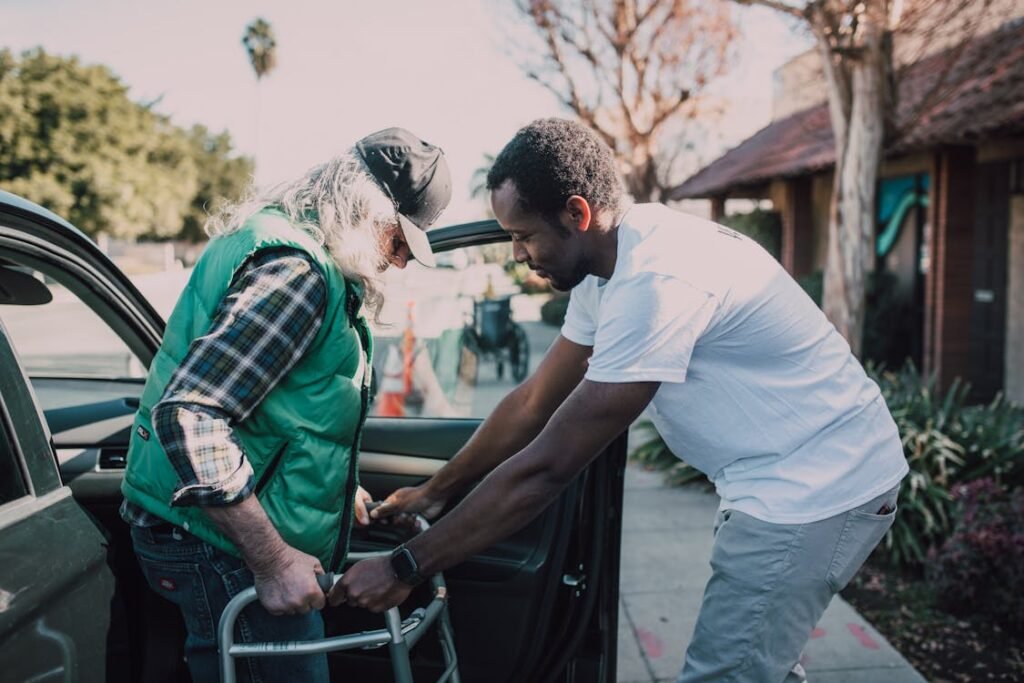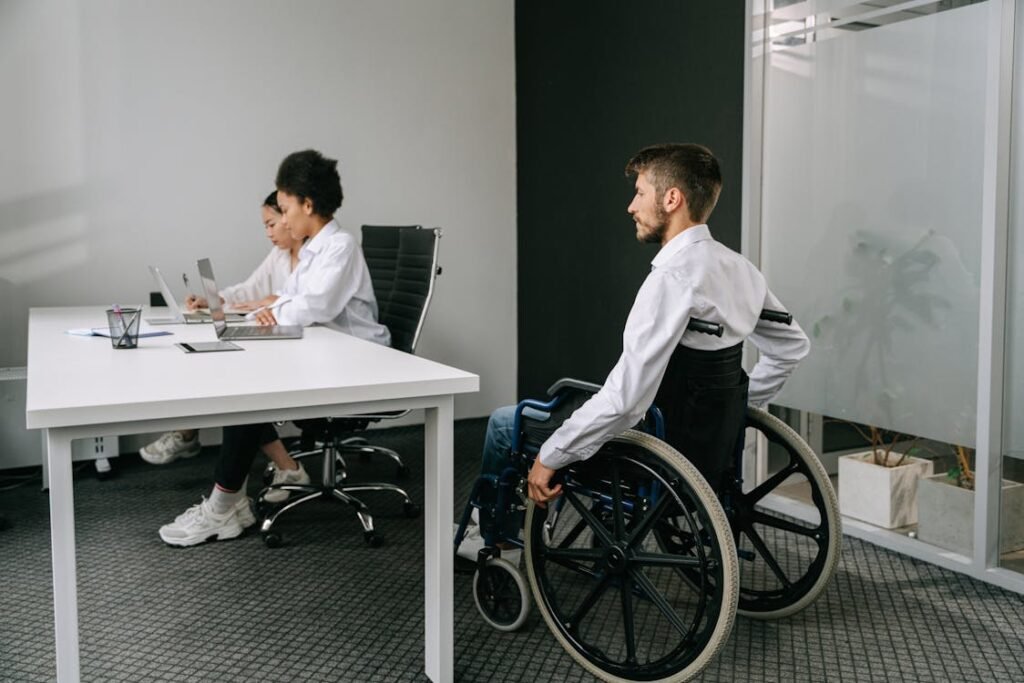Disability rights are human rights, yet millions of people with disabilities still face barriers in everyday life. From inaccessible public spaces to discrimination in workplaces, the challenges are many. While laws exist to protect the rights of disabled individuals, real change happens at the community level. Advocacy is essential in ensuring that people with disabilities receive equal opportunities, fair treatment, and the support they need to live independently.
Advocating for disability rights does not require legal expertise or government authority. It begins with awareness, education, and small actions that lead to bigger change. Whether you are a person with a disability, a caregiver, or an ally, you can play a role in making your community more inclusive. By understanding the issues, raising awareness, and working with local organizations, you can push for better policies, improved accessibility, and stronger enforcement of disability rights.

Understanding the Key Issues in Your Community
Before advocating for disability rights, it is important to first understand the challenges faced by disabled individuals in your community.
Every locality has different issues—some may lack accessible public transport, while others may have schools or workplaces that do not accommodate disabled individuals. Identifying these barriers will help you take targeted action and bring about meaningful change.
Observing Accessibility Barriers
One of the biggest challenges disabled individuals face is the lack of accessibility in public spaces. Many government offices, banks, hospitals, and even shops do not have ramps, elevators, or accessible restrooms.
Public transport, such as buses and trains, is often difficult for wheelchair users to board, and pedestrian pathways may be uneven or blocked, making navigation nearly impossible for those with mobility impairments.
Spending time in your community and observing whether places follow accessibility laws can help identify problem areas.
You may notice that a school does not have ramps for students using wheelchairs or that the local post office does not provide services for visually impaired individuals. By paying attention to these everyday barriers, you can better understand where improvements are needed.
Talking to People with Disabilities
The best way to learn about the struggles faced by disabled individuals is to listen to their experiences. Engaging with people who have disabilities, as well as caregivers and support groups, can provide firsthand insights into the challenges they encounter.
Conversations with disabled individuals can highlight issues that are often overlooked, such as difficulties in getting disability certificates, limited job opportunities, or discrimination in public services.
Community meetings, disability support groups, and social media platforms can be useful places to connect with disabled individuals. Understanding their concerns will help you advocate for meaningful solutions rather than assumptions about what they need.
Identifying Gaps in Law Enforcement
India has strong disability laws, such as the Rights of Persons with Disabilities (RPWD) Act, 2016, which mandates accessibility in public spaces, transportation, and workplaces.
However, enforcement remains weak in many areas. Schools that are legally required to provide inclusive education may not have special educators, and companies may fail to follow workplace accommodation rules.
Researching how well these laws are implemented in your community is an essential step in advocacy. If government offices, schools, or public transport systems are failing to comply with accessibility standards, this is an issue that needs to be addressed.
Speaking to local officials or reviewing government reports can help uncover gaps in law enforcement.

Taking Action to Advocate for Disability Rights
Once you have identified the key challenges in your community, the next step is to take action. Advocacy can take many forms, from raising awareness to working with local authorities to push for policy changes.
The goal is to ensure that people with disabilities receive the rights and opportunities they are entitled to under the law.
Raising Awareness in Your Community
Many people do not fully understand the challenges faced by disabled individuals. Schools, businesses, and even government offices often fail to consider accessibility because they are unaware of the barriers that exist.
One of the most powerful ways to drive change is by educating the public.
Community awareness programs, workshops, and social media campaigns can help highlight disability rights issues. Schools and colleges can introduce disability awareness programs to teach students about inclusion from an early age.
Businesses can be encouraged to make their workplaces more accessible by holding discussions with employees about the importance of hiring disabled individuals and providing necessary accommodations.
Another way to raise awareness is through storytelling. Sharing personal experiences of disabled individuals—whether through articles, videos, or community events—can help people understand the real impact of inaccessibility and discrimination.
When people hear real-life stories, they are more likely to support change.
Working with Local Authorities and Policymakers
Government officials and local leaders play a crucial role in enforcing disability rights laws. If public spaces, transport systems, or workplaces are failing to meet accessibility standards, it is important to bring this to the attention of decision-makers.
Writing to local authorities, attending public meetings, and engaging with disability rights organizations can help put pressure on the government to take action.
If a public building does not have a ramp or an elevator, filing a complaint with the State Disability Commissioner or the local municipal office can push for improvements.
If buses are not accessible, raising the issue with the transport department can lead to better policies being implemented.
In some cases, petitions and public campaigns can be effective in demanding change. Gathering community support and submitting a petition to local government offices can push authorities to act faster.
Social media can also be a powerful tool to highlight issues and bring attention to cases where accessibility laws are being ignored.
Encouraging Businesses to Adopt Inclusive Practices
Private businesses also have a responsibility to ensure accessibility and inclusion.
Many companies do not hire disabled individuals because they assume they cannot perform certain tasks, while others do not provide necessary accommodations such as ramps, accessible restrooms, or adaptive technology.
Encouraging businesses to become more inclusive can be done through direct engagement. Speaking with business owners, sharing information on accessibility standards, and recommending changes can help create awareness.
Some companies may not be aware of government incentives and tax benefits for hiring disabled employees, so informing them about these policies can motivate them to take action.
If a business refuses to comply with accessibility requirements, legal action can be taken. The Rights of Persons with Disabilities (RPWD) Act, 2016, mandates that private companies with more than 20 employees must provide reasonable accommodations for disabled individuals.
If a business violates this law, a complaint can be filed with the labor department or the State Disability Commissioner.

Supporting Individuals with Disabilities in Everyday Life
Advocacy is not just about policy changes and legal action; it is also about making daily life easier for people with disabilities. Small actions can have a significant impact, helping disabled individuals gain confidence, independence, and equal opportunities.
Encouraging inclusivity at the community level creates an environment where disabled individuals feel valued and supported.
Helping with Accessibility Challenges
Even when laws require public places to be accessible, many disabled individuals still struggle with everyday mobility. Sidewalks are often uneven or blocked, elevators may not function, and public transport remains unreliable.
Assisting individuals in overcoming these barriers can make a huge difference.
Helping someone navigate a crowded railway station, assisting them with an inaccessible ATM machine, or speaking to shop owners about making their entrances wheelchair-friendly are simple but powerful ways to create an inclusive community.
If a problem exists in a public space, reporting it to local authorities or raising it in community meetings can push for improvements.
Encouraging Inclusive Education
Many disabled children face barriers in accessing education due to lack of infrastructure, trained teachers, or social stigma. Schools often lack special educators or fail to provide accommodations such as braille books, assistive devices, or accessible classrooms.
Parents, educators, and community members can advocate for more inclusive education by engaging with school administrations and pushing for better facilities.
Encouraging schools to implement inclusive teaching methods, conduct disability awareness programs, and provide necessary accommodations can help children with disabilities receive the education they deserve.
If a school refuses to admit a disabled child or fails to provide necessary accommodations, the issue can be reported to the district education officer or the State Disability Commissioner. Legal action can also be taken under the Right to Education Act and the RPWD Act, 2016.
Creating Employment Opportunities
For many disabled individuals, finding employment remains a major challenge. Employers often hesitate to hire disabled workers due to misconceptions about their capabilities or concerns about workplace modifications.
Even when they do get jobs, disabled employees sometimes struggle due to a lack of necessary accommodations.
One way to support employment for disabled individuals is by encouraging local businesses to adopt inclusive hiring practices.
Engaging with employers, sharing success stories of disabled professionals, and educating businesses about workplace accessibility requirements can lead to more job opportunities.
For disabled individuals looking for work, connecting them with vocational training programs, job placement agencies, and government employment schemes can help them secure meaningful jobs.
Organizations like the National Career Service (NCS) and NGOs focused on disability employment provide job-matching services and skill development programs.
If a company refuses to hire a qualified disabled candidate solely based on their disability, legal complaints can be filed with the labor department or the Equal Opportunity Cell. The RPWD Act, 2016, mandates workplace inclusivity, and legal action can ensure compliance.

Building a Strong Disability Rights Movement in Your Community
Advocating for disability rights is most effective when done collectively. While individual efforts can bring change, a strong movement that involves multiple voices and organizations can create a lasting impact.
By uniting people around the cause, raising awareness at a larger scale, and collaborating with influential stakeholders, communities can ensure that disability rights are prioritized.
Forming Community Advocacy Groups
One of the best ways to strengthen disability rights advocacy is by forming or joining a local disability rights group. A community group can bring together people with disabilities, caregivers, activists, and allies to push for necessary changes.
These groups can work on projects such as conducting accessibility audits, organizing awareness campaigns, and holding meetings with local authorities.
Engaging with existing disability rights organizations can also provide valuable resources and support.
Groups such as the National Centre for Promotion of Employment for Disabled People (NCPEDP) and Disability Rights India Foundation (DRIF) work on policy advocacy and legal support.
Partnering with these organizations can help local groups amplify their voices and gain access to legal expertise.
Using Social Media for Advocacy
Social media has become a powerful tool for activism. By sharing stories, highlighting accessibility issues, and spreading awareness about disability rights laws, advocacy efforts can reach a larger audience.
Platforms like Twitter, Facebook, and Instagram allow individuals to raise concerns directly with policymakers, government agencies, and corporate leaders.
Many disability rights campaigns have gained national attention through social media. Posting pictures of inaccessible public spaces, tagging government officials in tweets about non-compliance, or sharing success stories of disabled individuals overcoming challenges can help create momentum.
Online petitions and digital campaigns can also put pressure on decision-makers to take action.
Engaging with Local Media and Public Officials
Local newspapers, television channels, and online news platforms can help spread awareness about disability rights.
Writing articles, giving interviews, or inviting journalists to cover accessibility issues in the community can bring public attention to the problem. When the media highlights these issues, authorities are more likely to respond.
Public officials, including municipal leaders, transport authorities, and legislators, have the power to make policy changes.
Advocates can engage with them by attending public meetings, submitting policy recommendations, or inviting them to disability rights events. Demonstrating the real-life impact of accessibility barriers and discrimination can encourage officials to implement better policies.
Encouraging Youth Involvement and Volunteerism
Youth activism has played a major role in many social movements, and disability rights are no exception. Schools, colleges, and universities can be encouraged to include disability awareness programs in their curriculum.
Student-led initiatives, such as volunteer programs to assist disabled individuals or university discussions on inclusive policies, can help create long-term social change.
Encouraging young people to participate in advocacy efforts ensures that future generations grow up understanding the importance of accessibility and inclusion.
Volunteer programs, mentorship initiatives, and disability awareness workshops can inspire more individuals to take action and contribute to building an inclusive society.

Overcoming Resistance and Challenges in Advocacy
Advocating for disability rights is not always easy. Many people, including policymakers, business owners, and even community members, may resist change.
Some may see accessibility improvements as unnecessary expenses, while others may simply be unaware of their legal responsibilities. Overcoming this resistance requires persistence, education, and strategic engagement.
Addressing Common Misconceptions
One of the biggest challenges in disability rights advocacy is changing attitudes. Many people wrongly assume that providing accessibility features is too expensive or that disabled individuals do not require equal opportunities.
Some employers believe that hiring disabled workers will slow down productivity, while school administrators may think inclusive education is too complicated to implement.
Challenging these misconceptions with facts and real-life examples is key to changing mindsets. Sharing stories of successful disabled professionals, explaining cost-effective accessibility solutions, and presenting case studies of inclusive businesses can help dismantle these false beliefs.
The more people see the benefits of accessibility, the more likely they are to support necessary changes.
Dealing with Bureaucratic Delays
Government agencies often move slowly when it comes to enforcing disability laws. Requests for accessibility improvements in public spaces may be ignored, and complaints about discrimination may take months or even years to resolve.
While this can be frustrating, persistence is essential.
Following up regularly with government offices, submitting written complaints instead of verbal requests, and escalating matters to higher authorities can help speed up the process.
If local officials fail to act, bringing media attention to the issue or engaging with disability rights organizations can put additional pressure on decision-makers.
Finding Support from Allies and Partners
Advocacy is most effective when done in collaboration with others. Partnering with local businesses, schools, and religious organizations can help spread awareness and gain community support.
When influential figures in a community—such as local leaders, religious heads, or business owners—speak in favor of disability rights, it becomes harder for authorities to ignore the issue.
Allies do not have to be disability rights experts. Anyone who believes in equality and inclusion can contribute by amplifying messages, organizing events, or simply ensuring that their own workplace or organization follows accessibility guidelines.
Building a network of supporters makes advocacy efforts stronger and more sustainable.
Staying Resilient in the Face of Opposition
Change does not happen overnight. Many disability advocates face rejection, slow progress, and even direct opposition from individuals who do not want to adapt. It is important to stay focused on the larger goal and celebrate small victories along the way.
Every accessibility ramp added, every new disabled employee hired, and every policy improvement achieved is a step forward. Advocacy requires patience, but the impact it has on people’s lives makes the effort worthwhile.

Leveraging Technology to Strengthen Disability Advocacy
Technology has become a powerful tool in the fight for disability rights. From increasing awareness to improving accessibility, digital platforms, assistive technologies, and data-driven advocacy efforts are transforming how communities push for change.
By using technology effectively, disability advocates can amplify their message, provide real-time solutions, and create long-term impact.
Using Mobile Apps and Digital Tools for Accessibility
Many new technologies are making it easier for people with disabilities to navigate the world.
Apps that provide real-time accessibility information, speech-to-text tools for deaf individuals, and AI-powered navigation assistants for visually impaired users are becoming more common.
Disability advocates can encourage businesses, government offices, and transport services to adopt these tools to improve inclusivity.
For example, digital mapping applications that identify wheelchair-accessible buildings and public transport routes can help disabled individuals plan their daily activities with more confidence.
Promoting and expanding such tools in local communities can bridge gaps where physical infrastructure remains inaccessible.
Social Media as a Platform for Change
Social media has revolutionized activism by allowing individuals to highlight issues instantly. Videos, photos, and testimonials can expose accessibility violations, document discrimination, and pressure authorities to take action.
Hashtag campaigns, viral posts, and online petitions can generate nationwide awareness and create momentum for policy changes.
Community groups can use platforms like Twitter, Facebook, and Instagram to track accessibility improvements, share updates on legal battles, and connect with policymakers.
Even a single viral post showing an inaccessible government building or an unfairly rejected disability pension application can push officials to respond faster than traditional complaint methods.
Online Education and Digital Inclusion
Lack of accessible education is a major challenge for people with disabilities, but online learning platforms are helping to close this gap. E-learning tools with features like screen readers, captioning, and customizable interfaces make education more inclusive.
Advocates can push schools, universities, and training institutes to ensure their digital platforms are designed with accessibility in mind.
Beyond formal education, digital platforms can be used to train businesses on disability inclusion, inform policymakers about accessibility laws, and teach people with disabilities about their legal rights.
Online webinars, virtual workshops, and disability awareness campaigns can reach a wider audience and create long-term social change.
Data-Driven Advocacy and Reporting
Technology also allows disability advocates to use data effectively. Crowdsourced accessibility audits, real-time reporting of violations, and digital surveys can provide evidence for policy recommendations.
When authorities see clear data showing how many places remain inaccessible or how many disabled individuals struggle to get jobs, they are more likely to act.
Advocates can work with software developers to create platforms that track accessibility issues in their communities. For example, a city-wide accessibility scorecard could rate businesses, government buildings, and public transport based on their disability-friendliness.
By compiling and sharing this data, communities can demand accountability and track progress over time.

Empowering People with Disabilities to Become Advocates
True change happens when people with disabilities lead the fight for their own rights.
While allies and activists play a crucial role, advocacy becomes more powerful when disabled individuals are directly involved in shaping policies, raising awareness, and holding institutions accountable.
Empowering disabled individuals with knowledge, skills, and platforms to advocate for themselves can create lasting change in communities.
Educating Disabled Individuals About Their Rights
Many people with disabilities are unaware of the legal protections and benefits available to them.
Laws like the Rights of Persons with Disabilities (RPWD) Act, 2016, provide accessibility rights, employment reservations, and financial support, but lack of awareness prevents many from claiming these entitlements.
Advocacy must start with ensuring that disabled individuals know their rights and how to exercise them.
Workshops, online courses, and community meetings can provide training on topics such as filing accessibility complaints, advocating for workplace accommodations, and applying for government schemes.
Schools, vocational training centers, and NGOs can integrate disability rights education into their programs to empower disabled individuals from an early age.
Encouraging Leadership Among Disabled Individuals
Disabled individuals must be represented in decision-making spaces. Encouraging them to take leadership roles in community organizations, advocacy groups, and local governance can strengthen the disability rights movement.
When disabled people are in positions of influence, they can drive policies that truly reflect their needs.
Organizations can support leadership development by providing mentorship programs, networking opportunities, and public speaking training for disabled individuals.
Encouraging them to participate in local government meetings, disability forums, and employment policy discussions can ensure that their voices are heard at all levels.
Building Confidence Through Self-Advocacy
Many people with disabilities hesitate to speak up about their challenges due to social stigma or fear of being ignored. Teaching self-advocacy skills can help them gain confidence in demanding their rights.
Role-playing exercises, communication training, and peer support groups can help disabled individuals navigate interactions with employers, government offices, and service providers.
Self-advocacy also includes being part of larger movements. Disabled individuals can contribute to disability rights campaigns, share their experiences in the media, and participate in legal cases that push for systemic change.
The more visible and vocal disabled individuals become, the harder it is for society to overlook their needs.
Strengthening Disability Communities
A strong disability community provides support, encouragement, and collective power. Disability-led organizations and online support groups can offer spaces for disabled individuals to share knowledge, seek advice, and collaborate on advocacy efforts.
When individuals come together, they can challenge institutions more effectively than when acting alone.
Community centers, NGOs, and digital platforms can help bring disabled individuals together to discuss challenges and work on solutions.
Creating mentorship networks where experienced advocates guide younger or newly disabled individuals can also strengthen the movement and ensure long-term activism.
Conclusion
Advocating for disability rights in your community is about more than just following laws—it is about ensuring that every individual has the opportunity to live with dignity, independence, and equal access. While legal frameworks like the Rights of Persons with Disabilities (RPWD) Act, 2016, provide protection, true change happens when communities actively push for enforcement and inclusivity.
Raising awareness, engaging with local authorities, challenging accessibility barriers, and empowering disabled individuals to advocate for themselves are all crucial steps in creating an inclusive society. Technology, media, and grassroots activism can amplify these efforts, making it easier to demand accountability and long-term change.
Progress may be slow, and resistance may exist, but every small action contributes to a more accessible world. Whether it is helping a disabled person navigate public spaces, pushing for workplace inclusivity, or reporting accessibility violations, advocacy starts with simple yet powerful steps.
At Robobionics, we believe in empowering individuals with disabilities through innovation. If you or a loved one is looking for prosthetic solutions to enhance mobility and independence, contact us today to learn how our advanced prosthetics, like Grippy™, can transform lives.




please check following two links, also I invite your kind attention towards why I am writing like this!
/profile/Badhan-Banerjee-PwBD-AMICE-I/Quota-Free-India-We-are-afraid-of-If-it-is-Quota-free-India-ie-the-lifting-of-the-reservation-system-from-educati https://www.quora.com/profile/Badhan-Banerjee-PwBD-AMICE-I/Quota-Free-India-We-are-afraid-of-If-it-is-Quota-free-India-ie-the-lifting-of-the-reservation-system-from-educati?ch=15&oid=221007703&share=dd131d38&srid=iVhqy&target_type=post
/profile/Badhan-Banerjee-PwBD-AMICE-I/Quota-Free-India-We-are-afraid-of-when-I-did-ask-perplexity-AI-If-it-is-Quota-free-India-ie-the-lifting-of-the https://www.quora.com/profile/Badhan-Banerjee-PwBD-AMICE-I/Quota-Free-India-We-are-afraid-of-when-I-did-ask-perplexity-AI-If-it-is-Quota-free-India-ie-the-lifting-of-the?ch=15&oid=221009708&share=9dab1fab&srid=iVhqy&target_type=post
Sir!
see my name, at a glance anyone understand I am disable. also, we can eliminate fake disabled.
Sir,
I also want to know who is best in world for DISABLED person advocay